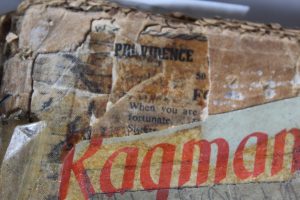From the first discussion about outcomes, Professor Nick Crowson made it clear that while he had a desired outcome (a catalogue of the Dosser’s Bible), Matt and Jess Turtle would have their own. As the founders of the Museum of Homelessness, and with direct links to the Simon Community, they wanted it to provide an insight into how and why the Dosser’s Bible was created. They grounded the project in the modern homeless sector, inviting myself and Nick to see the Community records, as well as to the launch of a St Mungo’s action plan.
Our goals changed greatly over the course of the project, however. Working with such an unknown resource like the Dosser’s Bible meant that the project had to be flexible. The articles weren’t placed in chronological order; some pages had themes, while others did not; the same names kept appearing. Often personal photographs were added, with no context or extra information to identify who was in them. This also meant that there was a vacuum of secondary sources that could provide guidance, with any confirmation having to come from other articles in the Bible, from Wallich-Clifford’s autobiography, or from the word of those who knew him (including his ex-wife, MT).

I visited the Museum of Homelessness’ main office in London with Nick to discuss what I’d found so far and to have a look at the original document. Being able to see it in person allowed me to realise how personally it had been put together, with a structure in mind. Each page was made from a cut-up paper bag, and some even had headings across the top. Going back to look at the beginning pages also highlighted the different handwriting on some of the articles, leading to the realisation that it wasn’t just Wallich-Clifford having articles cut by a company, but other people had been giving him articles they thought he would find interesting.
After a discussion with Nick, we came up with a solution to why the Dosser’s Bible was made. Wallich-Clifford had been collecting whatever he could find, trying to build a network, but also a guide to creating the Simon Community. A literal bible, detailing the homeless sector, what was being done, and what was needed, written and collected collaboratively.
But where did the name come from? While visiting the Museum, we were shown a copy of Simon Star, the spiritual successor of the Dosser’s Bible. Inside, it mentioned the Bible by name, discussing how it had been named by a student on a Simon Community staff training course. In this way, even the name was collaborative. It should not have been surprising how the Dosser’s Bible had been put together, as Wallich-Clifford’s main beliefs for the Community had always been that the staff and the homeless living with them should work together to recover from the streets and their addictions.
Elena Poulet, BA Ancient History
